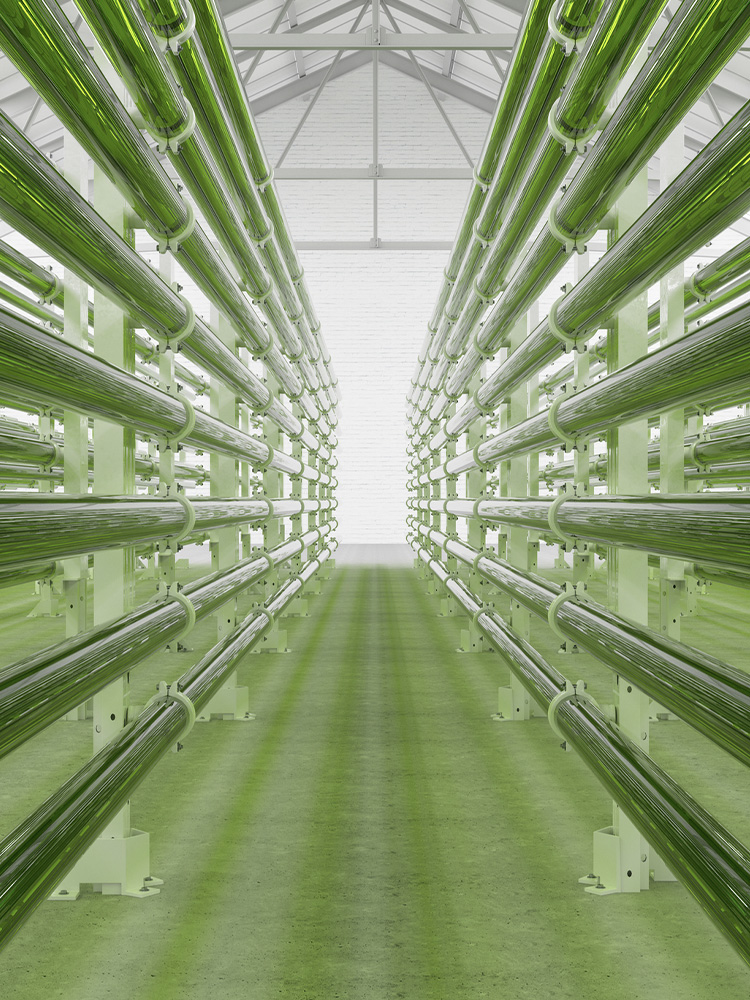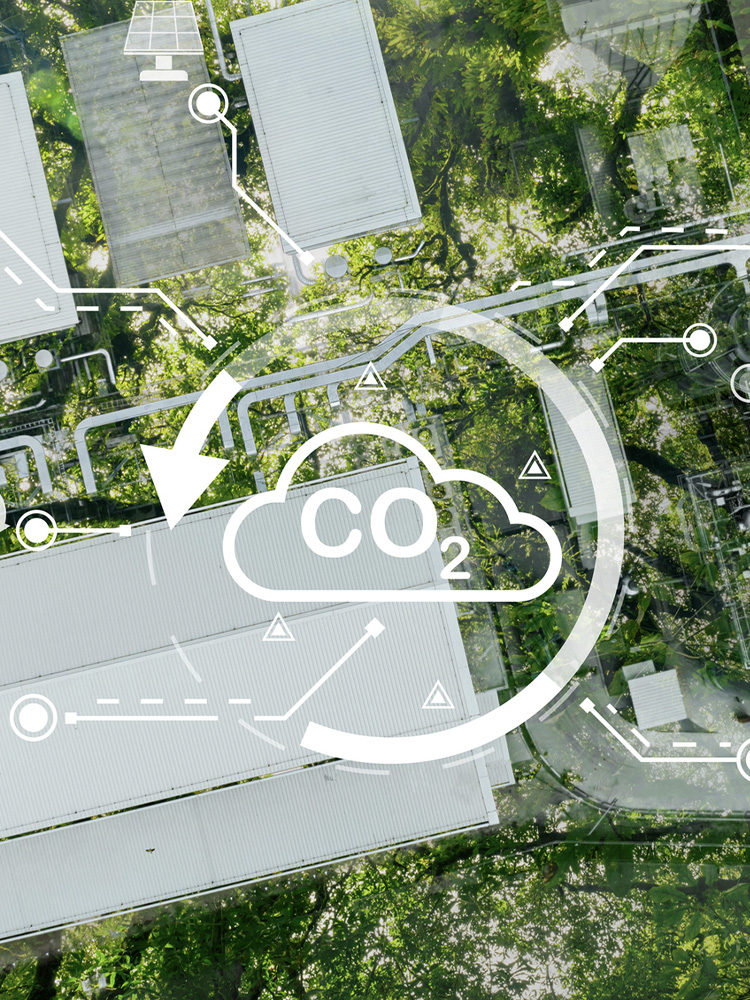The circular economy in CCUS: solutions for CO₂ capture and valorization
The CCUS sector is constantly growing, also driven by international policies and incentives that support investments in technologies for CO₂ capture, storage, and utilization to overcome challenges such as high costs. Public-private partnerships, innovation, and capture hubs are crucial to scale up projects and achieve Net-Zero targets by 2050.


CCUS: the impacts of CO₂ emissions and circular trends
Carbon dioxide (CO₂) is a greenhouse gas generated mainly by the combustion of natural resources of fossil origin (oil, natural gas, and coal) which, together with other climate-altering gases, contributes to trapping heat in the Earth’s atmosphere. Although the combustion of fossil fuels has been known for centuries, only in the past two hundred years industrialization based on intensive use of fossil fuels led human activities to release increasing amounts of greenhouse gases into the atmosphere, fueling the now well-established phenomenon of global warming.
According to the United Nations, the five main effects of climate change are:
- Higher temperatures: sweltering days, heat waves, the onset of heat-related diseases, and faster spread of wildfires;
- More intense storms: expansion of tropical storms, cyclones, hurricanes, and typhoons capable of devastating entire communities;
- Increased drought: water stress, sandstorms, and desertification;
- Warming and rising oceans: progressive melting of polar ice caps, ocean acidification posing severe risks to marine life, and the threat of sea level rise for coastal and island communities;
- Species loss: one million species at risk of extinction, proliferation of invasive pests, and spread of diseases.
The CCUS market: evolution and the importance of public-private partnerships
The CCUS (Carbon Capture, Utilisation and Storage) market is experiencing steady growth due to the diversification and heterogeneity of uses for captured CO₂. While in the past this was limited to a few sectors, such as the production of synthetic fuels, today it has multiple applications: from construction to polymer production, from the chemical industry to use as a base ingredient for innovative, high-protein foods.
A particularly interesting trend is the emergence and consolidation of strategic partnerships between private companies, government institutions, and research centers, aiming to accelerate the development and deployment of innovative technologies.
CCU Hubs
These collaborations often originate from a synergistic and multi-stakeholder approach, crossing national borders to create real international cooperation networks. Thanks to these synergies, so-called CCU Hubs are emerging — integrated industrial infrastructures that cover the entire value chain: from CO₂ capture plants to treatment systems and conversion facilities.
The role of storage technologies
The “S” in CCUS, referring to storage, includes all technologies aimed at safely storing captured CO₂, confining it underground and thus preventing its release into the atmosphere. Internationally, there is growing interest in implementing large-scale storage projects, supported by policies and incentives that promote the adoption of these solutions.
Valorization and storage of carbon dioxide represent two distinct approaches to applying Circular Economy principles to the sector: in the first case, the goal is to transform waste into a resource, while in the second, the waste is isolated to reduce the concentration of greenhouse gases in the atmosphere.


CCUS: regulatory framework analysis and incentives to foster development
One of the most debated aspects concerns the need for a clear and defined regulatory framework, enabling all actors involved - in particular private investors - to know “the rules of the game” and thus plan coherent investment plans, while reducing uncertainty about expected returns. From the European Union to the United States and major Asian economies, all governments are defining specific regulations within a broader program linked to the Decarbonization process.
The fundamental common objectives of the various international regulations can be summarized as:
- Definition of specific targets for CO₂ capture and utilization;
- Quantification of the investments in research and infrastructure needed to achieve these targets;
- The role of public and private stakeholders;
- Determination of economic and fiscal incentives to support the sector’s necessary development.
EU CO₂ Storage Directive (2009)
In this context, the first dedicated EU measure was the 2009 EU CO₂ Storage Directive, which defined the conditions for the safe capture, transport, and storage of CO₂ in geological formations, as well as guidelines for monitoring and controlling storage sites to ensure their long-term safety.
Fit for 55 Package
Also within the Fit for 55 package, issued under the Green Deal presented in 2019, CCUS is identified as a key set of technologies to reduce industrial emissions and support hard-to-abate industries, such as steel and cement.
EU ETS and Net-Zero Industry Act
In parallel, has been established the European Emissions Trading System (EU ETS), an European carbon market based on the cap-and-trade principle. This mechanism sets a maximum emissions cap allowed for specific production sectors, enabling obligated parties to trade allocated quotas. Under the EU ETS, CO₂ emissions that are captured and stored are not included in an installation’s total emissions calculation, thereby reducing the economic burden of purchasing carbon credits for the industries involved.
Finally, the European Commission has launched the Net-Zero Industry Act, which aims to achieve a storage capacity of 50 million tonnes of CO₂ by 2030 through the mobilisation of investments ranging from 9 to 12 billion euros.


The Italian regulatory framework
At the national level, by transposing the European Directive 2009/31/EC, Legislative Decree 47/2020 was published, paving the way for the launch of experimental offshore storage programmes. The regulatory framework was subsequently completed with Decree Law 181/2023, which enabled the issuance of storage permits and the establishment, within the Ministry of Environment and Energy Security (MASE), of a working group to define a business model for CO₂ transport and storage activities.
Operational projects and challenges
Despite a regulatory framework that is now largely defined, the number of operational projects for large-scale industrial carbon management in Europe remains limited. One of the main causes lies in the particularly high costs of identifying, developing, and assessing storage sites, as well as industrialising utilisation technologies that are truly sustainable.
The funding announced at European and national level for carbon capture and storage is not sufficient to support projects which, with current technologies, cannot cover their capital and operational costs relying solely on the carbon price in the ETS market.
EU tools for sector development
To support the sector’s development, the European Union has made available two tools: Horizon funds and the “Innovation Fund: Investments in Innovative Clean Technology Projects”, amounting to a total of more than 1.1 billion euros. Outside the EU, other countries have adopted various approaches ranging from tax incentives in the form of tax credits (as in the United States, through the Inflation Reduction Act) to structural funds for new projects (United Kingdom), including public-private partnerships (Norway) or direct state involvement (China).
Climate neutrality by 2050 and intermediate targets as challenges to overcome
There are still several open questions on how to concretely implement the projects, guidelines, and objectives promoted and envisioned by governments and international institutions, considering that the ambitious climate neutrality targets for 2050 will necessarily require a progressive decarbonisation path, with intermediate milestones that are already particularly challenging to achieve in the coming years.
Technological solutions and hubs for carbon capture and utilisation
Carbon Capture, Utilisation & Storage (CCUS) technologies are crucial for global decarbonisation, with strategic applications in sectors with the highest emission intensity, such as transport and industry.
E-fuels in the transport sector
In transport, for example, e-fuels are essential for the maritime and aviation sectors, as these are difficult to electrify. According to estimates, European production of synthetic fuels could grow from the current 250,000 tonnes per year in 2030 to 40 million tonnes by 2050, but the high production cost still limits their competitiveness on the market. The aviation sector aims to cover up to 70% of its needs with sustainable fuels by mid-century. An innovative example is Synhelion, a Swiss company that uses solar energy to produce synthetic fuels from CO₂ and water.
CO₂ in the chemical industry
Regarding industry, CO₂ is mainly used in the chemical sector, particularly for the production of polymers and additives, but this requires high purity standards and advanced technological processes. An interesting case is the Icelandic company CRI, which built a plant in China to convert CO₂ into methanol, allowing for emission reductions of up to 94%.
In the construction sector, concrete carbonation represents a mature technology for CO₂ storage, but in Italy development is hindered by regulations and costs. The company Carbon8 uses industrial waste to produce sustainable building materials.
Other innovative applications include the production of biogas, proteins for aquaculture (such as the US company NovoNutrients), urea, and polyols for adhesives and foams. Emerging solutions, like those developed by Norway’s Bergen Carbon Solutions, aim instead to transform CO₂ into advanced materials for next-generation batteries.
The success of CCUS technologies depends on the ability to create a collaborative ecosystem between the public and private sectors, the implementation of targeted economic incentives, and the piloting of demonstration projects in the chemical and construction sectors, with transport remaining a key testing ground.
The Hub & Cluster model
Hubs for carbon capture and utilisation represent an innovative and shared approach to reducing industrial emissions. The Hub & Cluster model, based on sharing infrastructure for the capture, transport, and storage of CO₂, makes it possible to optimise costs, reduce risks, and make these technologies more accessible and scalable.
The process is structured in three phases:
- Capturing CO₂ directly at industrial sites (cement plants, steel mills, refineries, etc.);
- Shared transport via pipelines, ships or trucks to a central hub;
- Storage or utilisation of CO₂ in depleted reservoirs or for the production of fuels, materials, and chemicals.
The advantages of this model include lower investment costs, simplified regulations, scalability, project acceleration, and the decarbonisation of sectors that are difficult to electrify.
Northern Lights CCS Hub
A successful example is the Northern Lights CCS Hub in Norway, operational since 2024. Developed by TotalEnergies, Equinor, and Shell, it allows industries from different countries to capture CO₂, transport it by ship and pipeline, and store it in saline geological formations 2,600 metres deep. The project, part of the Longship initiative recognised by the EU as a Project of Common Interest, foresees an initial capacity of 1.5 million tonnes per year, expandable to 5 million tonnes.
Conclusion
In conclusion, the Hub & Cluster model is confirmed as an effective solution to foster industrial decarbonisation, with significant potential to contribute to achieving European climate goals. However, its success will depend on political support, adequate investments, and cooperation between businesses.
